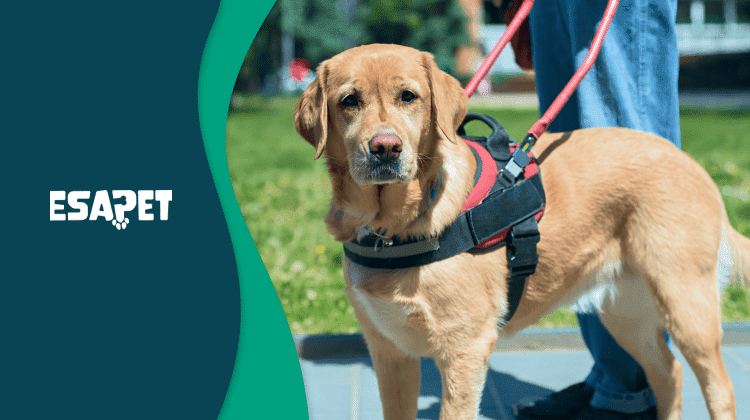How to Get a Psychiatric Service Dog: Steps and Requirements

Getting a PSD can make a huge difference for people with mental health disorders. These dogs are specially trained to assist with conditions like PTSD, anxiety, and bipolar disorder. They perform tasks that help manage symptoms and provide comfort.
What is a Psychiatric Service Dog?
A Psychiatric Service Animal or Dog (PSD) is a specially trained animal that helps individuals manage mental conditions. Unlike ESAs, which provide comfort through companionship, PSDs are trained to perform tasks. These tasks directly support their handler’s needs, helping them navigate daily challenges.
PSDs differ from emotional support animals in both training and legal rights. ESAs provide comfort but are not trained for specific tasks. PSDs assist with specific needs. This specialized training gives them access to public spaces where other animals are not allowed.
How to Get a Psychiatric Service Dog
The assessment and eligibility process for a pre-trained PSD involves matching you with a dog that meets your specific needs. It can take several weeks. Training a dog to perform specific tasks may last anywhere from four to eight months, depending on the task’s complexity.
Gather your medical records and necessary paperwork. Getting a PSD involves an extensive application process with a reputable provider.
Afterward, secure a PSD letter from ESA Pet through a three-step process. The first step is to fill out a quick pre-screening questionnaire. After that, participate in a teleconsultation. Finally, if approved, receive the letter.
Get your Official PSD Letter Consultation from a licensed therapist.
Get PSD Letter Now
Application Process and Paperwork for Psychiatric Service Dogs
The process for acquiring a PSD starts with a brief pre-screening to assess eligibility for a PSD letter. This involves evaluating aspects of your disability and the dog’s training. Following the screening, an LMHP will conduct a telehealth consultation to evaluate your needs further.
If approved, you will receive your PSD letter on official letterhead. This letter allows you to apply with a reputable service dog provider. This provider will review your application and match you with a trained dog tailored to your specific requirements.
How Long Does It Take to Get a Psychiatric Service Dog Letter?
The process of getting a PSD letter from ESA Pet includes a 2-minute pre-screening questionnaire followed by a teleconsultation. It typically concludes with issuing the letter within 24-48 hours after approval.
Who Can Get a Psychiatric Service Dog
Mental Health Disorders
Individuals with conditions like anxiety disorders, PTSD, and OCD may qualify for a PSD. These dogs perform specific tasks that help manage symptoms. The key is that the condition must create challenges that impact the person’s life.
Physical or Mental Impairments
A person’s physical or mental impairment must limit major life activities to be eligible for a PSD. The PSD’s role is to assist with these limitations. The dog makes it easier to navigate daily challenges. The dog’s assistance should directly relate to the tasks needed.
Licensed Mental Health Professional
An LMHP must verify the need for a PSD. They assess the severity of the condition and confirm that it impacts the person’s life. The LMHP provides documentation stating that the individual would benefit from a service dog’s support.
To qualify for a PSD, you must have a diagnosed mental health disorder that impacts your daily life. Common qualifying conditions include anxiety disorders, post-traumatic stress disorder (PTSD), and obsessive-compulsive disorder (OCD).
The service animal must be trained to perform tasks that address your condition’s symptoms. Your mental illness must substantially limit major life activities. An LMHP is essential for confirming eligibility. They provide the necessary documentation, including a PSD letter.
Common Mental Health Conditions for Psychiatric Service Dogs
Several mental health conditions make individuals eligible for a PSD. These include depression, generalized anxiety disorder, bipolar disorder, and schizophrenia. Each of these conditions can cause significant life challenges.
Diagnosis for a Psychiatric Service Dog
To get a diagnosis for a PSD, consult a licensed mental health professional. They will test your condition through assessments and discussions. Medical documentation is crucial for eligibility. This documentation proves your condition and explains how the PSD will assist.
Medical Evaluation and Documentation for a Psychiatric Service Dog
A medical evaluation is essential to qualify for a PSD. It determines if your disability meets the legal criteria. An LMHP conducts this evaluation. They assess how your condition impacts daily life and whether a PSD can help. This process ensures only those with valid needs receive a PSD.
Proper documentation is required to verify your eligibility. It must outline your condition and explain how the PSD will assist you. These documents provide the proof needed for service dog providers and public access. Let’s discover more about this in the following section.
What to Expect During a Medical Evaluation
During a medical evaluation, expect a review of your mental health. The professional may ask questions about symptoms or daily challenges. They will assess if your mental illness limits activities. This focuses on determining if a service dog can help manage your condition.
Required Documentation for PSD Eligibility
To qualify for a PSD, you must have an LMHP letter explaining your diagnosis and how a PSD can assist. Medical records showing your diagnosis, treatment history, and mental health status are important. You may also need proof of ongoing therapy or medication management.
Finding a Suitable Psychiatric Service Dog
Finding a PSD starts with understanding your options. It’s important to consider where the dog comes from and the required training level. You can find the Best Psychiatric Service Dog Breeds through local shelters or breeders. Each source offers different levels of training.
When finding a suitable PSD, breed matters. Some breeds are naturally more suited for this work. However, temperament and training play a bigger role. Research both the breed and the individual dog. The right match ensures the dog can meet your unique psychiatric needs.
Where to Find and Adopt Psychiatric Service Dogs
You can find PSDs through various sources. Local animal shelters have dogs with the right temperament but need training. Service dog organizations offer trained PSDs. Private breeders focus on breeding dogs. Some rescue groups may also have trained dogs.
Professional Breeders for Psychiatric Service Dogs
Professional breeders offer many advantages. They select dogs with the ideal temperament for service work. These dogs are calmer and easier to train. Breeders often begin basic training early. Their focus on genetics helps produce dogs that can handle psychiatric tasks effectively.
Training a Psychiatric Service Dog
Types of Training
Training a PSD includes teaching key skills like public access. It ensures the dog can behave well in public spaces. Task-specific training is also crucial. In this, dogs learn actions like DPT. These skills ensure that the PSD can assist their handler with their needs.
Self-Training vs. Professional Training
Self-training allows handlers to customize training to their needs and build a bond with the dog. It’s less expensive but requires time, patience, and training knowledge. Professional training provides structured lessons from experts. The choice depends on the handler’s resources and the dog’s requirements.
Training a PSD involves teaching specific skills. Public access training is critical. Essential skills include DPT to reduce anxiety and task-specific actions like retrieving medication. Professional training has a structured approach, while self-training requires time and patience.
Self-training allows flexibility, but it can be challenging. Professional training offers expertise, but it’s costly. Trained psychiatric service dogs often have consistent behavior. In self-training, owners guide their dogs through every step, but the results depend on the owner’s knowledge.
Where to train Psychiatric Service Dogs?
Essential Skills and Psychiatric Service Dog Tasks
PSDs are trained to perform critical tasks tailored to their handler’s needs. These include applying DPT during anxiety episodes. Tactile stimulation, like nudging, helps interrupt negative behaviors. These PSD tasks improve the handler’s ability to manage psychiatric conditions effectively.
Verifying the Legitimacy of Psychiatric Service Dog Providers
Identifying reputable PSD providers requires careful research. Start by checking if they provide detailed information about their training process. Legitimate providers are transparent about their methods. Be cautious if they promise quick results.
Watch for red flags that signal scams. Providers asking for large, non-refundable upfront fees without a contract are suspicious. Lack of clear communication should also raise concerns. Verify their reputation through reviews and testimonials.
Researching Service Dog Organizations
When evaluating a service dog organization, start by checking for accreditation. This ensures they follow established standards. Look for testimonials from previous clients. Investigate their training methods. Ethical providers tailor their training to meet individual needs.
Questions to Ask Potential Providers
When evaluating a provider, ask critical questions. How long have they been training PSDs? What training methods do they use, and how do they match dogs with individuals? Ask about ongoing support after the dog is placed.
Costs and Financial Assistance for Psychiatric Service Dogs
Typical Costs
The cost of obtaining and training a PSD can range from $10,000 to $30,000. Self-training can reduce costs. However, it still involves expenses for classes, equipment, and materials. Professional training is expensive but ensures the dog meets specific standards.
Financial Aid and Grants
Various non-profits and organizations provide grants to help cover the costs of a PSD. Some programs offer financial aid for veterans or low-income individuals. Crowdfunding through websites like GoFundMe is a common way to get support for training costs.
Health Insurance
Most health insurance plans don’t cover the full cost of getting a PSD. However, they may help with related expenses like veterinary care or medications. Some policies offer partial reimbursement if the dog is medically necessary for the handler.
Obtaining and training a PSD involves significant costs. A fully trained PSD can cost between $20,000 and $30,000. If you train a dog you already own, it may cost $150 to $250 per hour. Training requires consistency and time, adding up to several thousands of dollars.
Financial assistance options help ease the financial burden. Non-profit organizations offer grants specifically for service dogs. Some charities provide partial funding, while others may cover the full cost. Researching local and national programs can uncover valuable resources.
Legal Aspects of Psychiatric Service Dogs
PSD owners have specific legal rights under the Americans with Disabilities Act (ADA). The ADA ensures that PSDs have access to all public places where pets are not allowed. They are not required to wear special identification. However, they must behave in public spaces.
PSDs are also protected in housing under the Fair Housing Act (FHA). Landlords must allow PSDs in properties, even with no-pet policies. They cannot charge extra fees or deposits for PSDs. However, they can ask for documentation verifying the need for the service dog.
For details on the certification, read How to Obtain a Psychiatric Service Dog Certification.
PSD Letter from a Doctor
You must visit a licensed mental health professional to get a PSD letter. They will assess your condition and determine if a PSD is necessary. The letter must confirm your need for a PSD and how it helps with your disability. This document is essential for housing and public access rights.
Responsibilities of Owning a Psychiatric Service Dog
Owning a PSD comes with many responsibilities. Daily care is crucial. You need to feed them on time, groom them, and provide them with proper exercise. Regular vet check-ups are essential to ensure their health. These tasks help maintain their health and readiness to assist.
Besides physical care, PSDs need ongoing training. It’s essential to reinforce the skills they’ve learned and maintain appropriate behavior in public spaces. Owners must also ensure the dog behaves well in various settings.
Daily Care and Maintenance for Psychiatric Service Dogs
Daily care for a PSD involves feeding them nutritious meals consistently. You should provide regular grooming, such as brushing, nail trimming, and bathing. Ensure they get enough exercise through walks or play. Mental stimulation is also important.
Re-Certification or Ongoing Training for Psychiatric Service Dogs
Ongoing training is key to maintaining a PSD’s effectiveness. Regular practice ensures their skills don’t fade over time. Some organizations need re-certification to ensure the dog remains capable of performing tasks. It may involve evaluations to test their ability and public behavior.
Alternatives to Psychiatric Service Dogs
If a PSD isn’t the right fit, alternative support options exist. An emotional support animal offers comfort through companionship but is not trained to perform tasks. Therapy dogs provide emotional support in structured settings like hospitals or schools.
Unlike PSDs, neither ESAs nor therapy dogs receive extensive training. They offer emotional relief but do not perform tasks related to disabilities. ESAs provide support to their owners but lack public access rights. Therapy dogs can also not accompany individuals in public spaces.
Differences Between Psychiatric Service Dogs and Emotional Support Animals (ESAs)
A PSD performs tasks that assist with their handler’s disability. ESAs do not need any special training. PSDs have public access rights under the ADA and are allowed in housing under the FHA and on flights under the ACAA. ESAs only have housing rights under the FHA.
Alternatives to PSD Ownership
Owning a psychiatric service dog isn’t always the best solution for everyone. There are other support options. Pet therapy and community-based programs provide valuable alternatives. These offer mental benefits without the long-term commitment of a service animal.
Therapy programs like group counseling or equine-assisted therapy can provide ongoing support. Below are some alternatives that can complement or substitute PSD ownership.
Community-Based Therapy Programs
Community-based programs provide strong alternatives to service dog ownership. Equine therapy involves interacting with horses and helps individuals develop awareness. Group counseling offers peer support without the responsibility of owning a dog.
Pet Therapy as a Complement to Service Dogs
Pet therapy provides short-term emotional support in controlled environments. It involves trained service animals offering comfort during sessions. Pet therapy can relieve stress for individuals who do not need a full-time service dog. It’s a flexible solution to mental needs.
Additional Resources for Getting a Psychiatric Service Dog
Assistance Dogs International provides a directory of accredited service dog providers. ESA Pet; is a reputable PSD Letter provider. These resources help find trusted providers and understand the requirements for owning a PSD.
The Petco Love and Working Dogs for Vets offer grants to help cover the costs of obtaining and training a PSD. Support groups, such as Psychiatric Service Dog Partners, provide community-based assistance. These groups offer advice and resources for navigating the PSD process.
Frequently Asked Questions
- How Do I Make My Dog a Psychiatric Service Dog?
To make your dog a PSD, it must be trained to perform tasks that assist with your psychiatric disability. You can do this with the help of professional trainers or self-training. - How to Get a Letter for a Psychiatric Service Dog?
You need to consult a licensed professional to get a letter for a psychiatric service dog. They will test your condition and determine if a PSD is necessary. - Who Can Write a PSD Letter?
A licensed mental health professional, such as a psychiatrist, psychologist, therapist, or licensed counselor, can write a PSD letter. - What Is the Difference Between a Psychiatric Dog and a Service Dog?
A PSD is a type of service dog trained to assist with psychiatric disabilities. Service dogs perform tasks for disabilities. However, PSDs help with mental health conditions. Other service dogs may assist with physical impairments like blindness or mobility issues.
Contact ESA Pet
Need help getting a psychiatric service dog, applying for a PSD letter, or finding financial resources? Click the button to get expert guidance from ESA Pet.
Conclusion
Getting a PSD involves several key steps: confirming eligibility, applying with the right documentation, and selecting proper training. Ongoing care and support are also crucial. Explore available resources and consult with professionals to get through the process.









